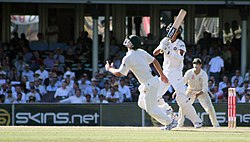
Back কট Bengali/Bangla कैच (क्रिकेट) Hindi ക്യാച്ച് Malayalam झेलबाद Marathi Caught Polish کیچ PNB பிடிபடுதல் (துடுப்பாட்டம்) Tamil క్యాచౌట్ Tegulu کیچ (کرکٹ) Urdu 接杀 (板球) Chinese


Caught is a method of dismissing a batsman in cricket. A batsman is out caught if the batsman hits the ball, from a legitimate delivery, with the bat, and the ball is caught by the bowler or a fielder before it hits the ground.
If the ball hits the stumps after hitting the wicket-keeper, If the wicket-keeper fails to do this, the delivery is a "no ball", and the batsman cannot be stumped (nor run out, unless he attempts to run to the other wicket.)
If the catch taken by the wicket-keeper, then informally it is known as caught behind[1] or caught at the wicket.[2] A catch by the bowler is known as caught and bowled.[1] This has nothing to do with the dismissal bowled but is rather a shorthand for saying the catcher and bowler are the same player. (The scorecard annotation is usually c. and b. or c&b followed by the bowler's name.)
Caught is the most common method of dismissal at higher levels of competition, accounting for 36,190 Test match dismissals between 1877 and 2012, which is 56.9% of all Test match dismissals in this period.[3]
South African wicket-keeper Mark Boucher holds the record for the most Test match catches, with 532,[4] while Rahul Dravid holds the record for the most Test match catches by non-wicket-keepers, with 210.[5]
- ^ a b "Ways of getting out: Caught". bbc.co.uk. 26 August 2005. Retrieved 2019-04-17.
- ^ "Runs for Vaughan but England caught short". theguardian.com. 13 December 2004. Retrieved 2019-04-17.
- ^ "Analysing Test dismissals across the ages". espncricinfo.com.
- ^ "Most catches in career". espncricinfo.com/. Retrieved 2019-04-17.
- ^ "Most catches". espncricinfo.com/. Retrieved 2019-04-17.
© MMXXIII Rich X Search. We shall prevail. All rights reserved. Rich X Search